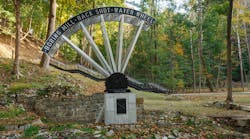The American Society of Mechanical Engineers (ASME) designated the West Point Foundry in Cold Spring, NY, as an Historic Mechanical Engineering Landmark. The ironworks was established in 1817 and began production in 1818 to supply the U.S. Army with artillery systems. It also produced some of the nation’s first steam engines, locomotives, and ironclad ships. Among the foundry’s various engineering accomplishments were producing cast-iron pipe for New York City's first water system, as well as Parrott guns — muzzle-loaded cannons used by the U.S. Army during the Civil War.
The foundry's owners also were business pioneers, according to ASME, being among the first domestic enterprises to implement integrated manufacturing, controlling all aspects of production from raw materials to product distribution. The operation also achieved many "proofs-of-concept" that helped to advance American mechanical engineering.
Foundry operations ceased in 1911, and since 1996 the site has been maintained by Scenic Hudson, an organization created to protect the "West Point Foundry Preserve" and its remains on approximately 90 acres.
Hiking trails follow old rail beds and pass extensive remains of the casting house, boring mill, and other former foundry structures that led to the preserve's inclusion on the National Register of Historic Places. Interpretive features — including a full-scale sculptural model of the 36-foot water wheel that powered the boring mill — demonstrate the role of West Point Foundry in the Industrial Revolution and the Civil War, and the site’s present reclamation.
Scenic Hudson calls it "the most intact example of a manufacturing site of its kind dating from the early decades of American industrialization."
The ASME Historic Mechanical Engineering Landmark adds the foundry site to a list of 272 artifacts now identified as historic mechanical engineering landmarks, heritage collections, or heritage sites. The ASME History and Heritage Committee selects these artifacts based on their engineering attributes, role in the evolution of the mechanical engineering profession, and significance to society in general.
“West Point Foundry Preserve is not only a beautiful park, but an outdoor museum that educates visitors about the early days of American industry and engineering,” stated ASME president Richard Laudenat. “ASME is pleased to formally recognize the foundry’s historical significance as part of the American Industrial Revolution and the evolution of mechanical engineering, as well as its role in inspiring new generations of engineers.”









